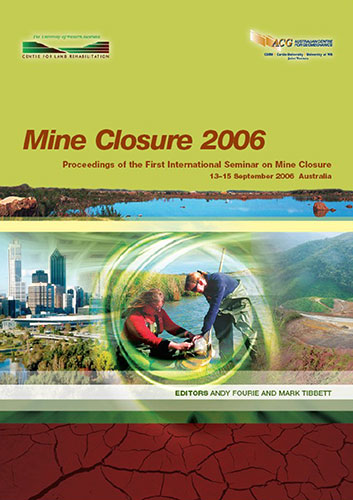Landscape Reconstruction Using Analogues at Ranger Mine, Northern Territory, Australia

|
Authors: Hollingsworth, I; Croton, J; Odeh, I; Buli, E; Klessa, D |
DOI https://doi.org/10.36487/ACG_repo/605_7
Cite As:
Hollingsworth, I, Croton, J, Odeh, I, Buli, E & Klessa, D 2006, 'Landscape Reconstruction Using Analogues at Ranger Mine, Northern Territory, Australia', in AB Fourie & M Tibbett (eds), Mine Closure 2006: Proceedings of the First International Seminar on Mine Closure, Australian Centre for Geomechanics, Perth, pp. 149-160, https://doi.org/10.36487/ACG_repo/605_7
Abstract:
We have developed an approach to designing a post-mining landform at Energy Resources of Australia (ERA) Ranger Uranium Mine that is based on analogues in the natural landscape so as to directly address the Environmental Requirements for closure, that is mined land should return to a condition consistent with the land use values and management of the surrounding Kakadu National Park, a World Heritage area. The Ranger Uranium Mine (RUM) is located within the 78 km2 Ranger Project Area (RPA), 250 km east of Darwin, in the Alligator Rivers Region of the Northern Territory. The land use values that the Mirarr Traditional Owners apply to the area are a key factor in the planned rehabilitation of the site. Consequently, planning for landscape reconstruction at Ranger Uranium Mine will begin with backfilling two mined-out pits with waste rock and tailings. However, the final landform and surface cover will need to be built in context with the undulating rises and savannah woodland environments in the surrounding landscape. Also, hill slope environmental processes that determine the sustainability and diversity of ecosystems in the vicinity of the mine need to be reflected in achieving revegetation success. In the seasonally monsoonal climate water balance processes operating at a hill slope scale, particularly those influencing plant available water and drainage are key factors affecting the type and vigour of native vegetation. In addition, the need to ensure that radiation health and water quality objectives can be met in the receiving environment at Ranger will be a critical issue. Consequently, the effects of revegetation and substrate on groundwater recharge and stream flow need to be investigated at the design stage.
References:
Cook, P.G. (1998) Water balance of a tropical woodland ecosystem, northern Australia: a combination of micro-
meteorological, soil physical and groundwater chemical approaches. Journal of Hydrology, 210, pp. 161-177.
Coops, N.C. and Catling, P.C. (2002) Prediction of the spatial distribution and relative abundance of ground-dwelling
mammals using remote sensing imagery and simulation models. Landscape Ecology, 17(2), pp. 173-188.
Croton, J.T. and Bari, M.A. (2001) Using WEC-C, a fully distributed, deterministic catchment model to simulate
hydrologic responses to agricultural clearing. Environmental Modelling and Software, Vol. 16, pp. 601–14.
Croton, J.T. and Barry, D.A. (2001) WEC-C: A distributed, deterministic catchment model — theory, formulation and
testing. Environmental Modelling and Software, Vol. 16, pp. 583–99.
Evans, K.G. (2000) Methods for assessing mine rehabilitation design for erosion impact. Australian Journal of Soil
Research, 38, pp. 231-47.
Gallant, J.C. and Wilson, J.P. (1996). TAPES-G: a grid-based terrain analysis program for the environmental sciences.
Computers and Geosciences, 22, pp. 713-722.
Hancock, G.R. (2004) The use of landscape evolution models in mining rehabilitation design. Environmental Geology
46, pp. 561-573.
Hancock, G.R., Loch, R.J. and Willgoose, G.R. (2003) The design of post-mining landscapes using geomorphic
principles. Earth Surface Processes and Landforms 28, pp. 1097-1110.
Hollingsworth, I.D. and Lowry, J. (2005) Landscape reconstruction at Ranger mine. In Proceedings of the North
Australian Remote Sensing and GIS Conference, Darwin, 4–7 July 2005, Applications in Tropical Spatial
Science (CD-ROM).
Mackey, B.G., Mullen, I.C., Baldwin, K.A., Gallant, J.C., Sims, R.A. and McKenney, D.W. (2000) Towards a Spatial
Model of Boreal Forest Ecosystems: The Role of Digital Terrain Analysis. Terrain Analysis Principles and
Applications, J.P. Wilson and J.C. Gallant (eds), John Wiley & Sons, Brisbane, pp. 391-422.
McGarigal, K., Marks, B.J. (1994) FRAGSTATS: Spatial Pattern Analysis Program for Quantifying Landscape
Structure. In. (Forest Science Department, Oregon State University: Corvallis)
Moore, I.D., Norton, T.W. and Williams, J.E. (1993). Modeling environmental heterogeneity in forested landscapes.
Journal of Hydrology, 150, pp. 717-747.
Planning for Closure
Mine Closure 2006, Perth, Australia 159
Nanson, G.C., East, T.J. and Roberts, R.G. (1993) Quaternary stratigraphy, geochronology and evolution of the Magela
Creek catchment in the monsoon tropics of northern Australia. Sedimentary Geology 83, pp. 277-302.
Nicolau, J.M. (2003) Trends in relief design and construction in opencast mining reclamation. Land Degradation &
Development 14, pp. 215-226.
Landscape Reconstruction Using Analogues at Ranger Mine,
Northern Territory, Australia
I. Hollingsworth, et al.
160 Mine Closure 2006, Perth, Australia
© Copyright 2025, Australian Centre for Geomechanics (ACG), The University of Western Australia. All rights reserved.
View copyright/legal information
Please direct any queries or error reports to repository-acg@uwa.edu.au
View copyright/legal information
Please direct any queries or error reports to repository-acg@uwa.edu.au